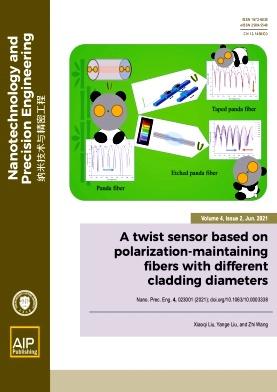Design and analysis of longitudinal–flexural hybrid transducer for ultrasonic peen forming
IF 2.7
3区 工程技术
Q2 MATERIALS SCIENCE, MULTIDISCIPLINARY
Nami Jishu yu Jingmi Gongcheng/Nanotechnology and Precision Engineering
Pub Date : 2023-08-04
DOI:10.1063/10.0020345
引用次数: 0
Abstract
Ultrasonic peen forming (UPF) is an emerging technology that exhibits great superiority in both its flexible operating modes and the deep residual stress that it produces compared with conventional plastic forming methods. Although ultrasonic transducers with longitudinal vibration have been widely studied, they have seldom been incorporated into UPF devices for machining in confined spaces. To meet the requirements of this type of machining, a sandwich-type piezoelectric transducer with coupled longitudinal–flexural vibrational modes is proposed. The basic structure of the transducer is designed to obtain large vibrational amplitudes in both modes. Experimental results obtained with a prototype device demonstrate the feasibility of the proposed transducer. The measured vibrational amplitude for the working face in the longitudinal vibrational mode is 1.0 μm, and electrical matching increases this amplitude by 40%. The flexural vibration characteristics of the same prototype transducer are also tested and are found to be slightly smaller than those of longitudinal mode. The resultant working strokes of the UPF impact pins reach 1.7 mm and 1.2 mm in the longitudinal and flexural modes, respectively. The forming capability of the prototype has been evaluated via 15-min machining on standard 2024-T351 aluminum plates. After UPF, an improved surface morphology with lower surface roughness is obtained. The aluminum plate test piece has an apparent upper deformation with an arc height of 0.64 mm. The measured peak value of the compressive residual stress is around 250 MPa, appearing at a depth of 100 μm. The proposed longitudinal–flexural hybrid transducer thus provides a high-performance tool for plate peen forming in confined spaces.超声喷丸成形纵弯混合换能器的设计与分析
超声喷丸成形(UPF)是一项新兴技术,与传统的塑性成形方法相比,它具有灵活的工作方式和产生的深层残余应力的巨大优势。虽然具有纵向振动的超声换能器已经得到了广泛的研究,但很少将其集成到UPF装置中用于密闭空间的加工。为了满足此类加工的要求,提出了一种纵向-弯曲耦合振动模式的三明治式压电换能器。换能器的基本结构被设计为在两种模式下都能获得大的振动幅度。实验结果证明了该传感器的可行性。测得工作面纵向振动幅值为1.0 μm,电匹配使工作面纵向振动幅值提高了40%。对同一原型换能器的弯曲振动特性也进行了测试,发现其弯曲振动特性略小于纵向振动特性。在纵向和弯曲模式下,UPF冲击销的工作行程分别达到1.7 mm和1.2 mm。通过对标准2024-T351铝板进行15分钟的加工,评估了原型的成形能力。经UPF后,表面形貌得到改善,表面粗糙度降低。铝板试件有明显的上部变形,圆弧高度为0.64 mm。实测残余压应力峰值在250 MPa左右,出现在100 μm深度。所提出的纵向-弯曲混合换能器因此提供了一个高性能的工具板喷丸成形在有限的空间。
本文章由计算机程序翻译,如有差异,请以英文原文为准。
求助全文
约1分钟内获得全文
求助全文
来源期刊

Nami Jishu yu Jingmi Gongcheng/Nanotechnology and Precision Engineering
Engineering-Industrial and Manufacturing Engineering
CiteScore
6.50
自引率
0.00%
发文量
1379
审稿时长
14 weeks
 求助内容:
求助内容: 应助结果提醒方式:
应助结果提醒方式:


